La ”Pasionaria” of Port Said
THE STORY OF MARIA UVA
Di Ermanno Salvatore
This story begins in the 1930s, when Egypt and the Suez Canal were controlled by the British.
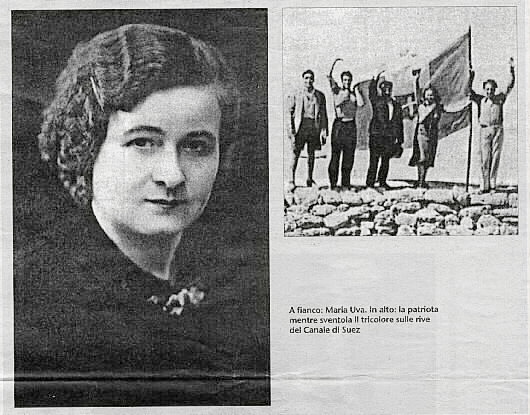 Those were the years in which the Italian warships, defying the threat of the British fleet,
passed through the Canal to reach the ports of Eritrea and Somalia. When they arrived in
Port Said, to begin the passage, they were greeted with enthusiastic demonstrations of affection by
Italian nationals residing in Egypt. Organizing the warm welcome was a young woman, resident of
Those were the years in which the Italian warships, defying the threat of the British fleet,
passed through the Canal to reach the ports of Eritrea and Somalia. When they arrived in
Port Said, to begin the passage, they were greeted with enthusiastic demonstrations of affection by
Italian nationals residing in Egypt. Organizing the warm welcome was a young woman, resident of
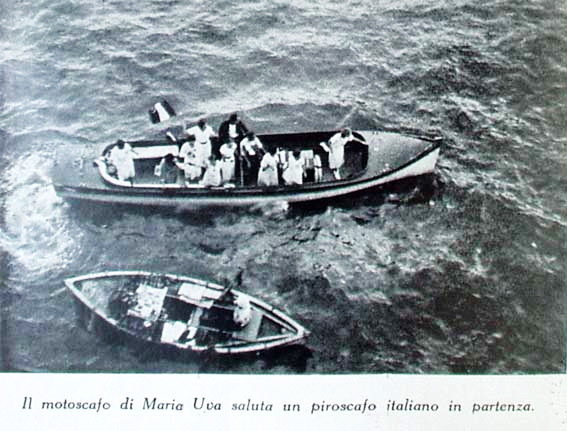 France and Egypt. She became famous throughout the world for the show of fervent patriotism which
delighted those aboard the vessels, especially the Italian soldiers.
Her name was Maria Uva, but everyone in Port Said called her "The girl of the Suez Canal"
What became a patriotic ritual of greeting and accompanying the ships of the legionnaires began by chance,
as the ship "Argentina" transited the Canal. Maria had gone with some friends to its banks to wave
the Italian flag. Such was the appreciation of the soldiers for the unexpected and joyous greetings of
those on shore that
France and Egypt. She became famous throughout the world for the show of fervent patriotism which
delighted those aboard the vessels, especially the Italian soldiers.
Her name was Maria Uva, but everyone in Port Said called her "The girl of the Suez Canal"
What became a patriotic ritual of greeting and accompanying the ships of the legionnaires began by chance,
as the ship "Argentina" transited the Canal. Maria had gone with some friends to its banks to wave
the Italian flag. Such was the appreciation of the soldiers for the unexpected and joyous greetings of
those on shore that
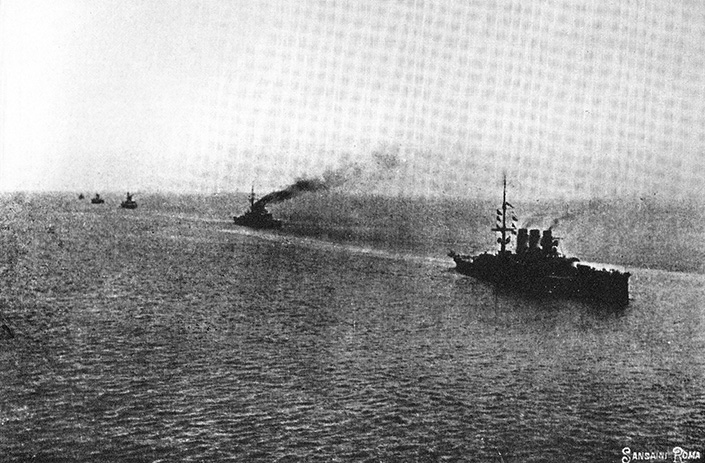 Maria decided to repeat the welcome and continue them throughout the period of the Ethiopian campaign.
Every day she rose at dawn and returned home at night, her voice totally spent, but by the next morning
she'd miraculously recovered. Born in France in 1906, Maria was orphaned while still just a child,
and forced by that tragedy to join her sister, who'd emigrated• some years earlier to Egypt.
As a young woman, she met an Italian, Pasquale Uva,and married him in 1933. Pasquale,
born in Egypt to parents from Apulia, lived in Port Said, where he managed a parking garage.
At the time of the Ethiopian campaign, in 1935-36, Maria, with her husband and other women of the
Italian communities of Port Said, Ismailia and Suez, began driving out to await the Italian ships at
the entrance to the Canal and follow them for as far as it was possible (almost 90 km) waving a huge
Maria decided to repeat the welcome and continue them throughout the period of the Ethiopian campaign.
Every day she rose at dawn and returned home at night, her voice totally spent, but by the next morning
she'd miraculously recovered. Born in France in 1906, Maria was orphaned while still just a child,
and forced by that tragedy to join her sister, who'd emigrated• some years earlier to Egypt.
As a young woman, she met an Italian, Pasquale Uva,and married him in 1933. Pasquale,
born in Egypt to parents from Apulia, lived in Port Said, where he managed a parking garage.
At the time of the Ethiopian campaign, in 1935-36, Maria, with her husband and other women of the
Italian communities of Port Said, Ismailia and Suez, began driving out to await the Italian ships at
the entrance to the Canal and follow them for as far as it was possible (almost 90 km) waving a huge
 Italian flag, shouting messages and greetings, and singing folk tunes and patriotic songs
through a megaphone. The Suez Canal was so narrow that you could talk without too much trouble with
the officers and soldiers aboard the ship. The soldiers, moved and surprised to find such a
reception so far from home, listened quietly to the songs of the women, but as. soon as the music ended,
they erupted with an irrepressible enthusiasm .A witness at the time, Col. Varo Varanini, wrote: "Maria
Uva, invoked from the bow, or called from the stern, sang on and on. Thunderous applause followed
each stanza, while a terrific cry rose from the deck, the bridge, cabins and holds, which had now
become a gallery, stage and auditorium. A floating theater, packed with thousands and thousands of
spectators."
Italian flag, shouting messages and greetings, and singing folk tunes and patriotic songs
through a megaphone. The Suez Canal was so narrow that you could talk without too much trouble with
the officers and soldiers aboard the ship. The soldiers, moved and surprised to find such a
reception so far from home, listened quietly to the songs of the women, but as. soon as the music ended,
they erupted with an irrepressible enthusiasm .A witness at the time, Col. Varo Varanini, wrote: "Maria
Uva, invoked from the bow, or called from the stern, sang on and on. Thunderous applause followed
each stanza, while a terrific cry rose from the deck, the bridge, cabins and holds, which had now
become a gallery, stage and auditorium. A floating theater, packed with thousands and thousands of
spectators."
 Maria, had become for all "the Nightingale of the Canal," "The Lady of Suez", "The Guardian Angel,"
"The Madonna of Legionnaires'," The Italian Flower", indeed, there was no counting the number of such
titles bestowed upon her. Sifting through the thousands and thousands of letters sent by those who saw
her, one reads emotional expressions of gratitude, not only from simple soldiers, for whom it may have
entailed great effort to write a few lines, but messages signed by important people.
In 1936, the Duke of Bergamo, commander of Division "Gran Sasso", praised Maria Uva, saying:
"She shared all the smiles and fervor of her heart, thus winning the gratitude of hundreds of
thousands of soldiers who will never forget and carry a precious memory of the example of
patriotism she offered them." The stories of Maria Uva soon spread abroad, in the letters sent home
by the • soldiers, who'd volunteered for the campaign from Italian communities around the world,
Maria, had become for all "the Nightingale of the Canal," "The Lady of Suez", "The Guardian Angel,"
"The Madonna of Legionnaires'," The Italian Flower", indeed, there was no counting the number of such
titles bestowed upon her. Sifting through the thousands and thousands of letters sent by those who saw
her, one reads emotional expressions of gratitude, not only from simple soldiers, for whom it may have
entailed great effort to write a few lines, but messages signed by important people.
In 1936, the Duke of Bergamo, commander of Division "Gran Sasso", praised Maria Uva, saying:
"She shared all the smiles and fervor of her heart, thus winning the gratitude of hundreds of
thousands of soldiers who will never forget and carry a precious memory of the example of
patriotism she offered them." The stories of Maria Uva soon spread abroad, in the letters sent home
by the • soldiers, who'd volunteered for the campaign from Italian communities around the world,
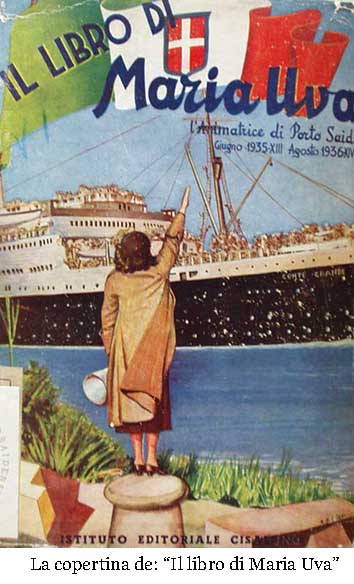
from the United States to Argentina, from France to Belgium, Germany to Tunisia. From these
letters we learn that in addition to the many Italian residents of Port Said, Ismailia and Suez,
who joined Maria Uva on the banks of the Canal, there was also a priest, Father Augustine Romoli,
who, even at night, boarded a speedboat, went on deck to bring greetings and blessings. Following
..his example, the ladies began to use boats to get as close as possible to the ships and make the
legionnaires feel even more welcome. It is said that at some point in the passage Maria called out
with the megaphone, that the road would soon cease to follow the .Canal for a few miles, adding:
"We won't be able to see you for about an hour, but the road rejoins the Canal shortly before Ismailia,
we'll meet there, goodbye. "And the soldiers waited. Even, if night fell no one wanted to go to sleep,
but, leaning against the railings of the ship, waited to resume singing with the "Italian sister."
Meanwhile, her popularity grew among the members of Italian communities around the world,
even in Brooklyn, where her image was displayed in the shops of Little Italy. Maria Uva had become
in a few months, the symbol of Italian patriotism. However, the sad day of reckoning would come,
the day when Maria and her husband would have to leave Port Said. The British had not forgiven
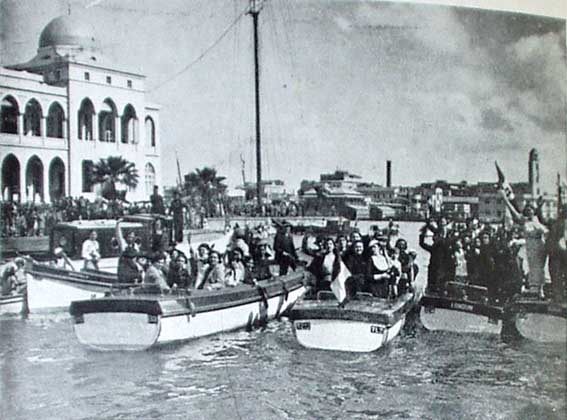
their "challenge". The business licenses of Pasquale were withdrawn, the Uva were left without vital
resources. Not only that, they were labeled "dangerous persons" and had to leave. In 1937,
Maria found herself in Rome at the Altar of the Fatherland and was later received at the
Palazzo Venezia, where she was given a badge adorned with a Roman sword with which Mussolini,
Duce of the Italian people, expressed gratitude for her exemplary patriotism. In Italy,
Maria and Pasquale found affectionate solidarity.They were aided by the Government to pay off debts
they'd been forced to run up in Egypt to survive, and both obtained respectable work.
But their problems were not over. In the years .that followed that terrible spring of 1945,
Maria Uva even risked being sentenced to death for her "Fascist past." She was rescued when,
thanks to the providential intervention of the Italian ambassador in Paris, she was able to show
that she was a French citizen. Thus, it would be a serious diplomatic incident. She'd had to leave
everything in Egypt, but bad managed to bring out her biggest treasure: all those letters from the
legionaries, thousands and thousands of them. She also wrote a book titled "The Book of Maria" which
tells of her sorties of those years up and down the Suez Canal.
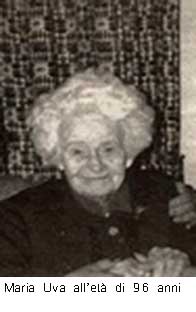
Pasquale, Maria's, died in 1969 in the
province of Forli in Meldola. But Maria lived to the age of ’97, dying on October
22, 2003. President of Italian Republic: Azeglio Ciampi had had her admitted to the
"David Drudi" Geriatric Institute of Meldola, where "The girl of Suez" spent her last years;
"a last, special, sign of affection for a kind lady, Maria Uva."
info@vastogirardiefriends.it
© 2010, www.vastogirardiefriends.it by Domenico Marchione